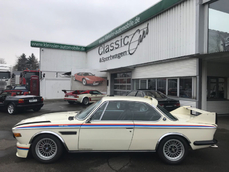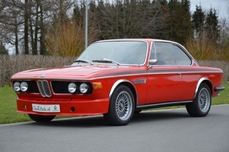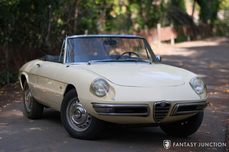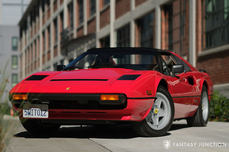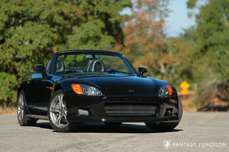BMW 3.0CSL e9 1973
Allmän beskrivning :
1973 BMW 3.0 CSL
s/n 2275047, Engine no. 2275047
Polaris Silver with Black Interior
BMW’s model line of the 1950s consisted of large expensive cars produced in very small numbers, such as the 501, 502, 503, and 507, and the single cylinder Isetta. As the 1960s began, BMW introduced the Neue Klasse sedans and coupes (which eventually became the 2002), creating the blueprint for their continuing success today: usable, accessible, and performance-oriented cars that sell in large enough numbers to sustain a global brand. Three years after the Neue Klasse’s 1962 introduction, BMW introduced a larger pillarless coupe (internally designated E9), initially with a 4-cylinder powerplant, and later with the now legendary M30 inline-6, which would power a wide variety of BMW models from its 1968 debut until the 1992 model year when it was replaced by a new V8.
Most E9s were luxurious and civilized touring cars, but from 1972, BMW decided to take the car racing in the European Touring Car Championship. In order to race, the car had to be homologated with at least 1000 examples for road use, and thus the roadgoing CSL (coupe sport leicht) was born. The CSL featured an aluminum hood, trunk, and door skins, thinner gauge steel used in the remaining body construction, unique lightweight sport seats, and correct alloy wheels. The engine displacement was increased and was available only with Bosch D-Jetronic electronic fuel-injection, making these cars very capable performance vehicles on both open roads and racetracks. Due to the car’s limited production, BMW assigned the construction of CSLs to a separate division, BMW AG, which later became BMW Motorsport GmbH, or “M” as the performance variants of today are known. 1,265 CSLs were hand built and sold to the public, laying the foundation for the BMW M division we know today. The CSL is a rare sight anywhere, and with none ever sold new in the United States, they are particularly rare here.
This handsome example is one of only 287 1973 CSL models constructed. According to the BMW Group Classic Zertifikat, this factory built Polaris Metallic CSL was constructed October 25, 1972. Service records accompanying the car date back to the early 1990s when the car resided in Europe. By 2013, the car had been imported to the US where roughly $8,200 was spent on brakes, discs, calipers, and a fresh set of Michelin XWX tires. Additional electrical work and general service was also performed at this time. According to an April 2013 receipt for service, the car had 52,550 miles indicated on the odometer. In November 2014, the car showed 52,571 miles when it was extensively serviced in La Jolla, CA at a cost of $14,800. Work performed on the car included replacing front and rear fuel hoses and rear metal fuel pipes, a new battery, new window regulator, a new E9 sway bar and bushings, new trunk light wiring harness, new differential mount and sub-frame mounts, new center exhaust resonator, new rear muffler, new tail pipe, ball joints, camber plate, upper and lower spring pads, a new power steering pump, new steering box, CV Boot kit and CV joint, and left and right control arms.
Today, this matching numbers CSL presents very with a combination of handsome original components and restored features, done only as needed. Exterior cosmetics are attractive with glossy paint done to nice driver standards. The body is straight and has good fit and gaps, with a few minor imperfections and a few minor spots of bubbling on the right rear fender just above the rocker trim and on the front valence. The alloy wheels and XWX tires give the car a wonderful stance, nicely offset by the attractive factory CSL stripes and emblems. The wheels were refinished and are nearly unmarked. The chrome trim has been redone nicely in a few areas while the grille surrounds, side grilles, and inner black areas are very nicely finished. Other brightwork components appear never to have been redone and show light pitting. The lighting, lenses, and script are all in very nice condition. The side glass garnish molding is tightly fit and properly polished, proudly reflecting the characteristic BMW Hofmeister Kink. The rubber seals appear tight and nicely fitting to the glass and chrome trim. Overall, the car is an attractive driver that makes a strong impression but remains at a level where the car can be enjoyed as often and enthusiastically as the owner wants.
The interior is nicely presented, and is in good basically unrestored condition. The correct lightweight Scheel front seats are in excellent condition, with great vinyl and corduroy inserts. The door panels, rear seating area, and headliner present nicely as a balanced part of the interior, all of which appear to be original and generally well preserved with light aging. The wood shows some cracking. The carpets are in nice condition with some minor wear evident in the driver’s area. The dashboard has a few cracks while the gauges are in very nice condition, showing good color and contrast, as well as very nice trim rings. The black Momo Prototipo steering wheel has a very purposeful look and feel to it with nice leather wrapping and BMW horn button. The chrome trim throughout the interior is very nicely preserved with many areas that are often worn form use still appearing in very nice condition. The center console and shifter boot appear in very nice condition.
The engine compartment is clean and detailed, with tidy appearance, correct finishes, and appropriate components per factory specification. Some of the components have been updated for modern motoring, but overall the presentation is authentic including, nice hardware and factory airbox, as well as correct Bosch fuel injection. The valve cover appears to have been repainted but is peeling in some areas. The engine numbers correctly match the serial number with the car as verified by the BMW Classic Certificate. The trunk is properly finished showing very likely original floor panels and carpeting, nicely preserved with evidence of minor aging and use in a few areas. The undercarriage is clean and dry, showing black painted and undercoated floor pans with no major structural issues obvious. Mechanical components are dry and in good condition, showing some evidence of the recent maintenance work.
The car is a pleasure to drive. Despite its competition ethos, the car is generally civilized to drive, with a pleasant touring car feel until the driver starts to ask more of the car, at which point its true competence becomes very clear. The engine starts easily and idles well, with the classic BMW big six exhaust and mechanical noise. The throttle is responsive and the fueling is very good, with no hesitation and remarkable performance. The clutch is progressive and relatively light, the shift linkage straightforward to use, and the gearbox shifts smoothly with good synchromesh. The brakes are effective and linear in their operation, and the car has good control harmony, with no aspect of the car standing out as mismatched with the rest of the car. The ride quality is very good and the noise level underlines the impression of civility. Steering effort is neither heavy nor light, with a natural feel that puts the driver at ease. Handling is similar, with a good blend of comfort and performance. The chassis is balanced and neutral in character, and when pressed, the car transforms from a civilized cruiser to a lively, adjustable and engaging sports car in a way that reflects its competition heritage. It has a wonderful duality that is atypical in cars of this vintage.
Specially homologated by BMW for road use, and destined for racing achievement, this enthusiastically maintained matching-numbers 3.0 CSL offers attractive cosmetics, recent extensive service, and exceptional rarity and collectability. Rarer than both the Gullwing and the 73RS, but a genuine homologation car, a pleasure to drive quickly, and a pivotal moment in BMW history, the CSL remains something of a bargain. This particular car is ready to enjoy and would be ideal for events thanks to its attractive but not perfect condition and recent sorting.
http://fantasyjunction.com/cars/2128-BMW-3.0%20CSL-3.0%20Liter%20Inline-6
1973 BMW 3.0CSL e9 is listed såld on ClassicDigest in Emeryville by Fantasy Junction for $205000.
Fakta i bilen
Karosstyp : Personbil Märke : BMW Modell : 3.0CSL e9 Motorvolym : 3.0 Årsmodell : 1973 Karosstyp : Coupé Läge : Emeryville
Såld
Information om säljaren
Såld
People who viewed this BMW 3.0CSL e9 also viewed similar BMW listed at ClassicDigest
Other cars listed for sale by this dealer
om BMW
Bayerische Motoren Werke, allmänt känt som BMW, har en rik historia som sträcker sig tillbaka till grundandet 1916. Ursprungligen etablerat som en flygmotortillverkare under första världskriget, ställdes BMW inför restriktioner när det gällde flygplansproduktion efter kriget. Som svar på detta skiftade företaget 1923 fokus till motorcykeltillverkning, vilket markerade början av deras deltagande inom bilindustrin. Därefter inträdde BMW i bilvärlden 1928 genom att producera DIXI, i huvudsak en licensierad version av Austin 7 från Austin Motor Company.Under 1930-talet började BMW etablera sig som tillverkare av eleganta och högpresterande fordon. En framstående modell från denna tid är BMW 327, som introducerades 1937. 327 fanns tillgänglig som både coupé och cabriolet och visade företagets engagemang för lyx och stil. Dessutom nådde BMW framgångar inom sportbilsracing under denna period, särskilt med modellen BMW 328. BMW tävlade med 328 i olika racingevenemang, inklusive det prestigefyllda Mille Miglia, där företaget introducerade flera aerodynamiska specialmodeller.
Efterkrigstiden var utmanande för BMW, och företaget stod inför ekonomiska svårigheter som nästan ledde till konkurs. Trots detta lyckades BMW återhämta sig och återuppbygga sig, och blev så småningom en av de ledande premiumvarumärkena globalt.
När 1960-talet rullade in befäste BMW ytterligare sitt rykte som tillverkare av sportiga och lyxiga fordon. År 1968 introducerades BMW 2002 och markerade födelsen av "New Class" av kompakta, sportiga sedaner. 2002 blev populär för sitt smidiga hantering och prestanda och lade grunden för BMW:s sportiga image.
I och med 1970-talet utvidgade BMW sitt sortiment med introduktionen av plattformen E9, som inkluderade den ikoniska BMW 3.0 CS-coupén. E9-serien visade BMW:s engagemang för att kombinera prestanda och lyx. År 1972 gjorde M1, BMW:s första mittmotordrivna sportbil, sin debut. M1 utvecklades ursprungligen som en tävlingsbil men blev senare också en bil för allmän väg. M1 lade grunden för BMW:s högpresterande M-serie.
Mot slutet av 1970-talet introducerades BMW E24 6-serien och erbjöd en kombination av lyx och prestanda. 6-serien inkluderade modeller som 630CS, 633CSi och 635CSi och blev en symbol för sofistikering och körglädje.
Genom dessa milstolpar och en satsning på innovation och prestanda har BMW utvecklats till en gigant inom bilindustrin och behåller sin status som ett av de ledande premiumvarumärkena globalt.


